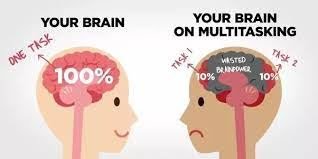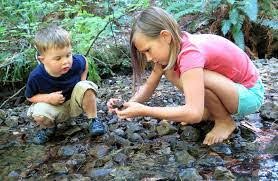Study/Work Tips
Schedule breaks for every block of homework/work time (no phones until break).
Use a phone safe if needed
Design a space conducive to school/work.
Set time limits and goals before rewarding yourself with an activity.
Consider going old school and write notes.
Turn phone on airplane mode and consider noise cancelling headphones for ultimate focus
Use a computer that is only for school/work.
We are Multi-switching!
Dr. Paul Mohapel Dark Side of Devices
When we are doing the mythical activity of multitasking this leads to fragmented thinking.
“The more we become used to sound bites and tweets, the less patient we will be with more complex, more meaningful information” (Thomas Kersting).
Commonsense media said multitasking affects kids learning, schoolwork and memory.
For every time you take a look at your phone, it takes you 15-20 minutes to get back and be focused. Dr. Paul Mohapel (local neuroscientist)
Children & Screen Time
If a child sees or hears something the brain doesn’t recognize as correct or normal (i.e.. Animated figures, dancing letters) they will focus on it until the brain determines it is not a threat = becomes passive, absorbed, mesmerized and zoned into the screen
A body at rest tends to stay at rest (based on first law of physics)
Continued exposure to high levels of sensory input = real life seems slow = boredom and inattentiveness.
What to Try
Simplify our homes
Play
Let kids be bored and use imagination
Media has convinced us the real world is dangerous
According to a CBS report, companies spent nearly $17 billion marketing to kids, increasingly targeting tweens and younger children.
Note: Rainbow Friends, Huggy Wuggy, Siren Head (these seem child friendly but can be scary - try to view content before your kids do)
Impact on Children/Youth
Resource: Dr. Mari Swingle – wrote I-Minds book
Cradle to 3 – can affect attachment
3-9 – can effect emotional regulation and attention and development of stimulus systems.
Adolescent – can affect social and sexual
Not feeling emotions(escaping into tech)
I can see you are mad right now, I am right here with you. Or I can give you space if needed. (builds self-soothing and resiliency)
What are we not getting from time spent on screens?
Need time for boredom, reflection, relationships and creativity.
Kids not connected to someone in person are more at risk.
Engagement with internet is causing more loneliness Dr. Anna Lembke
Sleep & Digital Technology
SLEEP impacts physical
and mental health immensely
Stick to alarm clocks (not phones)
Movement means more need for rest
Use family charging stations
Lock box if needed
Use Flux (adjusts blue light to time of day.
Earplugs/Sleep mask
Alarm/phone(if you need it in room) across room
Have no screens in bedrooms, especially at night (blue light and dopamine)
½ of teens moderately to severely sleep deprived (Dr. Jean Twenge)
Attention
Typical college student focuses on 1 task for 65 seconds
Typical officer worker focuses for 3 minutes
Degradation of sustained reading
Absorb less when reading on a screen. Read linear in a book. On screens we are eye scanning which leads to less comprehension and this pattern takes over when you go to a book.
Resource: Johan Hari from his book Stolen Focus
Control wifi, don’t take away device, hardware level(unless Electronic Screen Syndrome), program modem, cut connections to certain devices, limit data (2.5 GB only).
Reward not a right - they do something as part of their development and earn tech time. Not a daily time unless they do something.
Negotiate a schedule, start low - review regularly.
If don’t do activity - lose time.
If aggressive - 30 min consequence of tech time lost.
Everyday is a clean slate.
Tips:
Caught in flow (distortion of time/dopamine effect when win or lose)
2 hours(of junk food content) is totally healthy. Above 7 hours of play has neurological impact on brain.
Most addictive games are MMORPG
Resource: Unplugged Psychologist
Please check out his resources, book and courses.
Canadian Pediatric Society (2017)
New guidance released still urges no screens at all for kids younger than age two, except to video-chat with others such as grandparents, and says kids aged two to five should restrict "sedentary screen time" to one hour a day. (2023)
Focus on how and when screens are used rather than how long. (Michelle Ponti, CPS, 2021
Nir Eyal(Hooked and Indistractable books).
3 hours or less not a concern, 3 hours or more, always a co-morbidity.
The Canadian Pediatric Society has ditched a hard-and-fast time limit for screen use among toddlers and preschoolers, encouraging instead that parents prioritize educational, interactive and age-appropriate material.
Looking online for what we are not getting in real life. What are they not participating in?
Less likely to go out of house or have friends over to house.
When older kids aren't getting enough unplugged down time, it can lead to:
Depression and anxiety, social challenges, and isolation, lack of confidence, compromised immune system, irritability, issues with sleep, stress and overwhelm (Susan Stiffleman, MFT, wrote Parenting Without Power Struggles).
Surgeon General says 13 is too young for Social Media use (Dr. Vivek Murphy, 2023)
News
Senate Judiciary Committee
For more than a decade, social media companies have been performing a vast uncontrolled experiment on our children. They use the realms of data they collect on young people and endless A/B testing to fine tune their platforms’ algorithms and design to maximize engagement, because more time and activity on a platform means more revenue.
And because the way these platforms engage with young people is largely unregulated, there is no obligation to consider and mitigate the harmful effects of their design choices on children and teens.
The resulting impact on children and families has been devastating. Compulsive overuse, exposure to harmful and age-inappropriate content, cyberbullying, eating disorders, harms to mental health, and the sexual exploitation of children are just some of the problems linked to Big Tech’s insidious business model.
It doesn’t have to be this way. Instead of prioritizing engagement and data collection, apps, websites, and online platforms could be built in ways that reduce risks and increase safeguards for children and teens. With many young people now spending a majority of their waking hours online and on social media, improving the digital environment so it is safer and not exploitative or addictive is one of the most important things we can do to address the mental health crisis.
Josh Golin Fairplay, February 14, 2023
Researchers conducted a study on 89 families, consisting of 181 children and 184 adults
“We found that children in the screen reduction intervention group had an average of 45 min more daily physical activity compared to children in the control group,” This shows how balancing kids' screen time "should be a public health priority" because it can "substantially" increase their physical activity. (JAMA Pediatrics 2022)
What’s unique about the 2021 iteration of the metaverse is that it includes fully immersive 3D VR and AR worlds that transcend screen viewing by putting the user inside the game spatially. This can impact how bullying, harassment, and lewd content, as well as positive content, are experienced by users in the metaverse. Recent reports of virtual sexual assault and other crimes.
South Korea has declared a public health crisis as more than 600,000 children are struggling with problematic gaming. 8.4% of children and teenagers are addicted - 11-12% of boys and 6-7% of girls.
In Roblox users are able to create their own virtual games for each other. This has led to some users creating "virtual strip clubs" and other NSFW-content areas. Katie, a teenager who plays Roblox, shared with Rolling Stone Magazine that "for a few hours a day, she goes to strip clubs and gives lap dances to patrons and has virtual sex with anonymous players."
Unplugged Canada
call to action
We check in with Jenna Post from Unplugged Canada NS chapter to discuss the groups call to action amidst the federal election campaign and learn more about and an event that will explore how smartphone use affects boys and girls differently.














